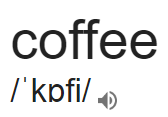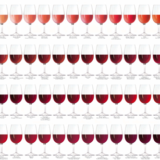50 Shades of Vowels
 Look at these glasses of wine from a French winery. Obviously they are all reds. Now let me ask you: Which one is really red? There are lots of shades of red, as you can see. Which one is a true red color? See if you can guess correctly. You’ll find the right answer in a moment.
Look at these glasses of wine from a French winery. Obviously they are all reds. Now let me ask you: Which one is really red? There are lots of shades of red, as you can see. Which one is a true red color? See if you can guess correctly. You’ll find the right answer in a moment.
Of course, this blog post is not about color. It’s about sounds. We are going to examine what the correct sound is for a particular phoneme. For example, let’s look at the first vowel sound in the word “coffee”. What the correct pronunciation of the “o”? Is it the /ɒ/ sound as in olive? Is it the /ɔ/ as in law? Or is it /ɒ/ as in cloth (British)? These are three distinct sounds or phonemes defined by IPA. Which one would you use to pronounce coffee? Which one is the right one?
While you’re thinking about that, let’s go back to the wine. Have you figured out which glass has the true red color? I would say that the real red is in the glass which is in the third row down, third from the right. But I’d be wrong. In fact, they are all red and there is no “true” red. So any one you picked is both correct and incorrect. It’s red for you, but you could pick any of the glasses and still be correct. Now it’s unlikely that anyone would say that one of the glasses in the top row are red. They are shades of red, but they lean so far towards the light (white) end of the spectrum that we don’t really consider them red. We would give them another label, like “pink” or as the French might say, “rosé”.
Now let’s leave the wine and go back to coffee: Which is the correct pronunciation of that “o” in coffee? If you haven’t guessed it already, there is no correct pronunciation. They are all valid pronunciations and any barista with a basic knowledge of English would be able to understand what you were ordering and serve you a coffee, regardless of how you pronounced the o.
So if I look up coffee in Google.com I get these pronunciations:

And in Google.co.uk I get yet another alternative:

We like to think that each defined phoneme has a specific sound; that there is a specific way to pronounce the a-sound or i-sound or u-sound. But in fact the sounds are quite fluid and when we talk about a particular sound we are really just coming to a rough consensus of what that sound may be from a range of sounds. To go from ˈkɑfi and ˈkɔfi involves just the very slightest rounding of the lips. It’s like comparing one shade of red to another. However, if I round my lips even more to make a ˈkoʊfi sound then I’ve gone to a shade that is close in many ways, but obviously far enough away from what would thought of as the /ɑ/ or /ɔ/ to be acceptable. In a sense, I’ve gone from a red to a rosé.
Opening or closing the mouth slightly, moving the tongue forward or back slightly, or moving the lips forward or back slightly all shift sounds slightly and give them different shades. These nuances are what make English so interesting, yet so confusing. It’s why we can drink coffee or cawfee or give birth to a dawder or a dodder (daughter). It’s also why we can’t say that one is the correct pronunciation or not.
If you are a teacher, don’t be dogmatic about the exact sound of any particular phoneme. If you are a student you can relax a little bit about how to exactly pronounce a sound. As long as the position of your jaw, lips, and tongue are somewhere in an acceptable range, you’ll be understood.
In other words, as long as the shade of red is close to what others consider red, we’re fine. All this shading is what gives us a fantastic range of dialects and accents, and what makes the speech of every individual uniquely theirs.













